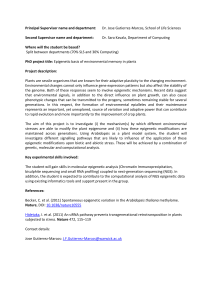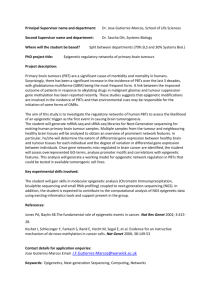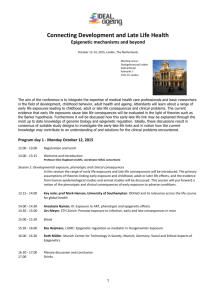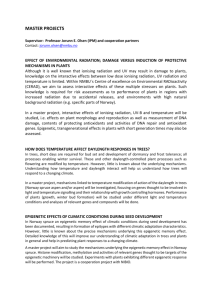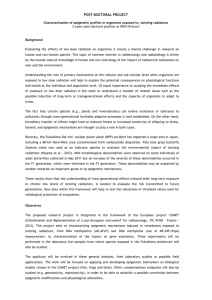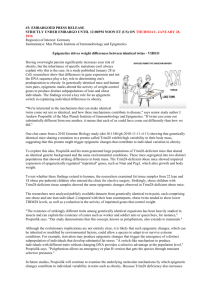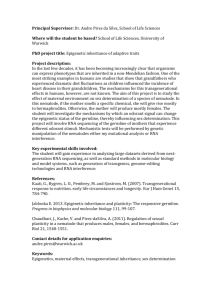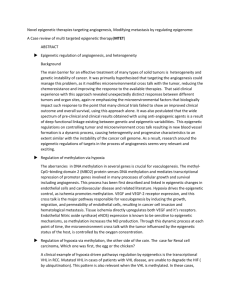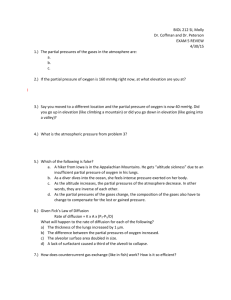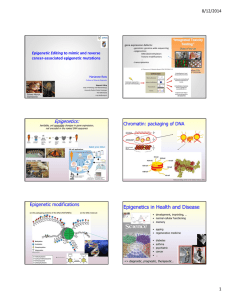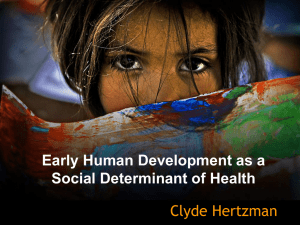locus cell
advertisement
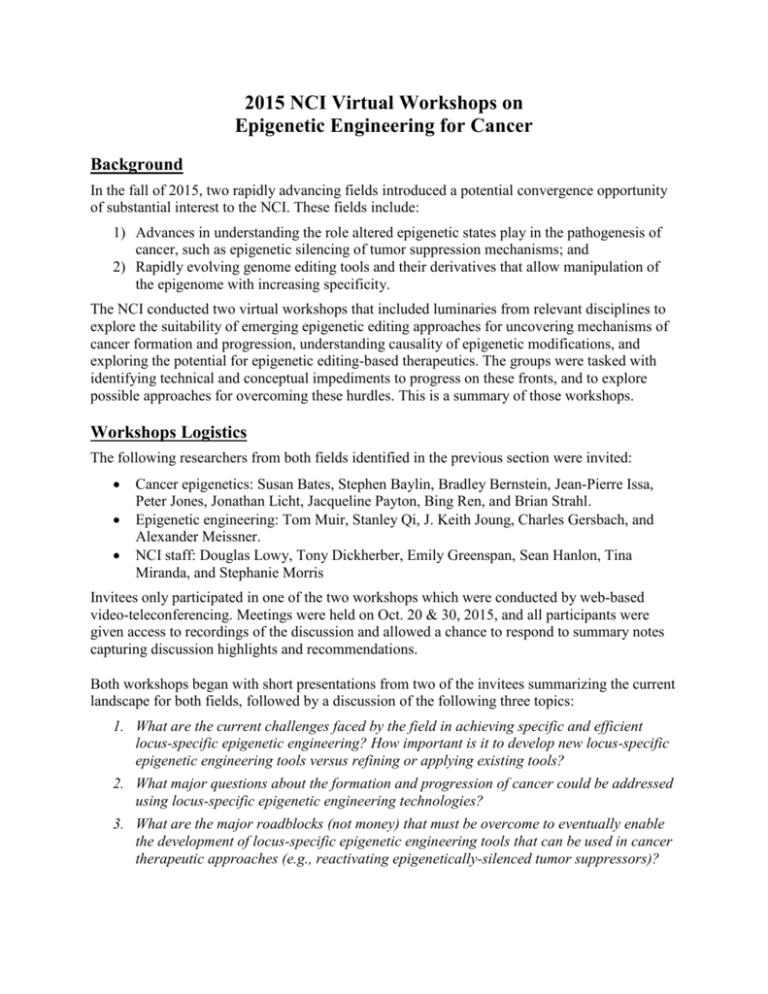
2015 NCI Virtual Workshops on Epigenetic Engineering for Cancer Background In the fall of 2015, two rapidly advancing fields introduced a potential convergence opportunity of substantial interest to the NCI. These fields include: 1) Advances in understanding the role altered epigenetic states play in the pathogenesis of cancer, such as epigenetic silencing of tumor suppression mechanisms; and 2) Rapidly evolving genome editing tools and their derivatives that allow manipulation of the epigenome with increasing specificity. The NCI conducted two virtual workshops that included luminaries from relevant disciplines to explore the suitability of emerging epigenetic editing approaches for uncovering mechanisms of cancer formation and progression, understanding causality of epigenetic modifications, and exploring the potential for epigenetic editing-based therapeutics. The groups were tasked with identifying technical and conceptual impediments to progress on these fronts, and to explore possible approaches for overcoming these hurdles. This is a summary of those workshops. Workshops Logistics The following researchers from both fields identified in the previous section were invited: Cancer epigenetics: Susan Bates, Stephen Baylin, Bradley Bernstein, Jean-Pierre Issa, Peter Jones, Jonathan Licht, Jacqueline Payton, Bing Ren, and Brian Strahl. Epigenetic engineering: Tom Muir, Stanley Qi, J. Keith Joung, Charles Gersbach, and Alexander Meissner. NCI staff: Douglas Lowy, Tony Dickherber, Emily Greenspan, Sean Hanlon, Tina Miranda, and Stephanie Morris Invitees only participated in one of the two workshops which were conducted by web-based video-teleconferencing. Meetings were held on Oct. 20 & 30, 2015, and all participants were given access to recordings of the discussion and allowed a chance to respond to summary notes capturing discussion highlights and recommendations. Both workshops began with short presentations from two of the invitees summarizing the current landscape for both fields, followed by a discussion of the following three topics: 1. What are the current challenges faced by the field in achieving specific and efficient locus-specific epigenetic engineering? How important is it to develop new locus-specific epigenetic engineering tools versus refining or applying existing tools? 2. What major questions about the formation and progression of cancer could be addressed using locus-specific epigenetic engineering technologies? 3. What are the major roadblocks (not money) that must be overcome to eventually enable the development of locus-specific epigenetic engineering tools that can be used in cancer therapeutic approaches (e.g., reactivating epigenetically-silenced tumor suppressors)? Discussion Highlights Overviews In both introductions covering our current understanding for how epigenetic lesions contribute to cancer, there was agreement that such lesions are widespread in advanced stages of most cancers, but the degree to which such lesions are inconsequential bystanders, early-stage enablers or otherwise primary drivers of any given cancer is still largely unknown. Both groups independently suggested the need for better models to study these questions, including better cell lines, animal models and even organoids or other 3D in vitro models. Both introductory speakers summarizing this field also independently raised the need for better theoretical frameworks that might drive better research strategies. Pioneering studies using a variety of established and recently developed technologies were presented as examples for how one might explore these questions, but there was broad agreement that our general understanding of epigenomic mechanisms in cell biology are still scanty. With regards to the current landscape of epigenetic editing tools, both groups identified substantial shortcomings with the existing approaches; which encompasses CRISPR/Cas9, TALEN, and ZFN techniques1. In spite of the known shortcomings, there was substantial and unanimous enthusiasm for these tools to eventually allow highly-specific epigenetic engineering to study the contribution of independent lesions to downstream malignancy. Each approach offered its own unique shortcomings, but both introductions sited the CRISPR approach as the easiest to implement with much development work still left to do to yield a reasonably efficient and reliable tool for the research community. Both introductory speakers casting the current landscape for this technology development field explained a strong need to share resources and methods to more thoroughly understand those approaches that work, those that are difficult to replicate, and others that have struggled to succeed. An important component for supporting further development of these tools will involve improved monitoring tools to verify the effectiveness of intended modifications as well as to monitor endogenous states and downstream cellular responses to induced changes. First Topic: Roadblocks to achieving intended modification of epigenetic targets While there was substantial enthusiasm for the CRISPR/Cas9 method generally, fundamental limitations for currently known constructs (e.g., large size, inefficient targeting, and significant off-target effects) suggests a substantial need to continue supporting efforts advancing TALEN and ZFN capabilities as well. Both groups identified ZFN techniques as offering greater efficiency and specificity for targeting, but much more difficult to engineer than Cas9 modifiers. Both groups clearly advocated for a resource to share information and materials associated with methods that work and methods that don’t work. Furthermore, both groups raised the need to have better approaches for verifying and monitoring site-specific modifications at high temporal and spatial resolution, regardless of whether or not that modification induced a phenotypic change in the cell population. The second group in particular stressed the need to monitor such effects at the single cell level. Also of interest is monitoring the sustainability of modifications 1 Clustered, regularly interspaced, short palindromic repeats (CRISPR); CRISPR-associated protein 9 (Cas9); transcription activator-like effector nuclease (TALEN); zinc-finger nuclease (ZFN) beyond overall efficiency. Throughout both meetings, participants stressed the general insufficiency of our understanding of cellular epigenetics as a substantial hurdle to progress. Second Topic: Roadblocks to studying epigenetic lesions that might be addressed by locusspecific tools Both groups suggested that the community is largely ready to use site specific modifiers to understand epigenetic mechanisms of cell biology, but is still waiting for the tools to exhibit sufficient functionality. For example, investigators may target known regulators and activities with a more comprehensive toolbox to track how one modification or combinations and patterns of modifications affect the genetic landscape at one or more genes. Alternatively, one may target enhancers and follow the impact on genes or organization of chromatin at the single cell level, or otherwise might have models of formation and progression of cancer that can be studied by systematically studying sequences of events and how they each might contribute and the importance of the order of events. Both groups reiterated the need for better models and better systems for monitoring endogenous states. The second group offered hopefulness in emerging high resolution microscopy platforms that might offer the monitoring capabilities needed, but also emphasized the insufficiency of currently available cell lines for studying cancer generally. Third Topic: Roadblocks for therapeutic strategies based on targeting epigenetic aberrations The groups diverged slightly in considering the foreseeable potential of using such tools as part of a primary therapeutic strategy. The first group suggested too many known deficiencies and unknown peripheral factors substantially diminish enthusiasm for pursuing therapeutic strategies directly with these tools for the near term. This group suggested that focusing on developing easy-to-use tools so as to validate putative targets would likely be the most impactful pursuit therapeutically for now. Alternatively, the first group suggested there might be potential in targeting epigenetic loci that could produce an immunologic effect similar to where these sitespecific editing approaches have seen therapeutic success in genomics. The second group highlighted problems specifically with the size of the Cas9 enzyme as well as TALENs (albeit, to a lesser degree) for developing direct therapeutic agents. There was some enthusiasm for the potential of designing ZFNs for this purpose, though. Similar to the first group, they questioned how efficient and specific any technique had to be to achieve a desirable effect, but were ultimately more optimistic about the potential for direct therapeutics with these agents, generally. The need for more sensitive and real-time monitoring tools and better models were again emphasized during this discussion. Conclusions NCI program staff are extremely grateful to all participants for their time and generous contributions to these discussions. NCI is currently attempting to prioritize the recommendations we received, identify complementary programs and initiatives which may be leveraged, and develop an action plan for pursuing the priorities in alignment with the NCI mission.
